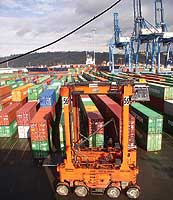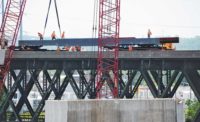Federal reauthorization of surface transportation, aviation and intercity rail funding bills was a hot topic for the 250 attendees at the June 23-24 conference in Washington, D.C., sponsored by The Bond Buyer, a national municipal finance publication. "Some call it the perfect storm, but I call it opportunity," said Phyllis F. Scheinberg, deputy assistant transportation secretary for budget and programs. She pushed the Bush administration's $247-billion SAFETEA highway and transit proposal, claiming it would expand financing tools and encourage private-sector involvement.
 |
| CONGESTION Freight transportation is getting more attention. (Photo courtesy of the Port of Tacoma) |
But participants were concerned over surface transportation and aviation bills expiring Sept. 30 while the congressional clock ticks toward legislators' mid-August recess. Slow progress on the bills has raised fears that Congress may settle for a stopgap transportation funding bill. Scheinberg worries that would require tapping the trust fund. "Then we won't have enough money when we do have a long-term bill," she says.
Tax shortfalls have impacted many state transportation programs. The Colorado Dept. of Transportation has lost $643 million in tax revenue since fiscal 2002, a figure that could climb to $2.5 billion by 2011, said Thomas E. Norton, state DOT executive director. He added that state finances have been aided by a "more favorable" bidding climate and more "in-house" design.
Kam Movassagi, secretary of the Louisiana DOT, hopes the private sector can help cut costs. The state plans shortly to conduct its first review of cost-savings from the 2002 hiring of an outside program management team to manage its $3.5-billion capital investment program. "We wanted a robust reporting system of how we're spending funds," he said, noting that the PM's fees are dependent on cost savings. "Then, we'll decide if it goes to the second year."
Despite funding stresses, capacity shortfalls and public needs will remain. "We're leveraging all we can," said Frank Kruesi, president of the Chicago Transit Authority. He says much of the system is antiquated and CTA plans for express rail links between downtown and the city's two airports.
Despite airline problems, airport work still is attracting project financing. Dan Champeau, managing director of Fitch Ratings, noted that in 2002 his firm identified $85 billion in capital needs through 2008 that would require $30 billion in new borrowing.
Freight and intermodal transportation are gaining more attention and investment. Freight is "more congested now than highways," said Thomas McLaughlin, head of the western region for MBIA Insurance Corp. Jeff Holt, a Goldman Sachs vice president, noted that even the new Alameda Corridor in Southern California may soon be insufficient. He warned that massive gridlock in Chicago's rail system could upend the economy without an upgrade that could cost $1.3 billion in its first phase alone.
But transportation officials say unplanned security investments already are affecting planned capital programs. Security upgrades at U.S. ports could cost $1 billion this year alone, said Tom Rousakis, a Morgan Stanley & Co. vice president.
For example, a $146-million renovation at Boston's Logan Airport to accommodate new baggage scanners caused work on new gates to be deferred, said Betsy Taylor, Massachusetts Port Authority's finance director. The PA obtained grants from the Transportation Security Administration and related DOT agencies to fund some security work, but the process is convoluted and in flux.
The Florida Ports Council will spend $150 million for security this year, said John R. LaCapra, president. "We can't pay for law enforcement without using our capital dollars," he said. "We are putting our fingers in the dike right now."
roject finance experts and municipal officials swapped stories of funding shortages and the steps they are taking to address them at a recent transportation finance conference. While falling tax revenue and uncertain federal funding plans have many sweating, conferees pondered tactics ranging from taking work in-house, outsourcing to program managers, and private and alternative public financing to stretch their shrinking dollars.

Post a comment to this article
Report Abusive Comment